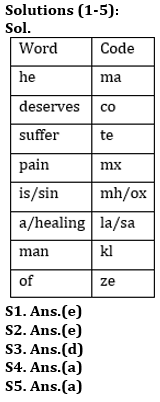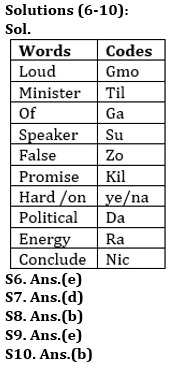Directions (1-5): Study the following information carefully and answer the given questions:
In a certain code language,
‘He deserves suffer Pain’ is written as ‘ma co te mx,
‘Pain is a healing sin’ is written as ‘mx mh la sa ox’,
‘Man suffer Pain’ is written as ‘mx te kl’
‘Deserves is sin of Man’ is written as ‘kl mh co ze ox’.
Q1. What does the code ‘la’ stand for in the given code language?
(a) Pain
(b) is
(c) a
(d) healing
(e) Either (c) or (d)
Q2. What is the code for ‘sin’?
(a) kl
(b) ox
(c) mh
(d) ze
(e) Either (b) or (c)
Q3. In the given code language, which of the following means ‘a healing sin’?
(a) la sa mh
(b) sa la ox
(c) ox sa mh
(d) Cannot be determined
(e) mx mh la
Q4. What does the code ‘co’ stand for?
(a) deserves
(b) suffer
(c) he
(d) Pain
(e) Either (a) or (c)
Q5. What is the code for ‘he’ in the given code language?
(a) ma
(b) te
(c) co
(d) mx
(e) mh
Directions (6-10): Study the following information to answer the given questions.
In a certain code language,
‘Loud of Speaker minister’ is written as `ga gmo til su’
‘Hard false loud promise on’, is written as ‘kil zo gmo ye na’
‘Minister false political energy’ is written as `zo ra til da’
‘Political conclude of promise’ is written as `da ga nic kil’.
Q6. What is the code for ‘on’?
(a) ye
(b) na
(c) zo
(d) Either na or zo
(e) Either ye or na
Q7. What does `su’ stand for?
(a) minister
(b) loud
(c) of
(d) Speaker
(e) None of these
Q8. What is the code for ‘energy loud conclude’?
(a) nic ye til
(b) gmo ra nic
(c) ra ga gmo
(d) da ra nic
(e) None of these
Q9. Which of the following does `kil til na’ stand for?
(a) promise of loud
(b) hard loud promise
(c) minister promise hard
(d) minister promise on
(e) Either (c) or (d)
Q10. Which of the following may represent ‘beyond limits of loud’?
(a) ga zo til da
(b) ga ba gmo nee
(c) ga ba nic kil
(d) gmo ba til ra
(e) None of these
Directions (11-15): In these questions, a relationship between different elements is shown in the statements. The statements are followed by two conclusions. Give answer
Q11. Statement: L≥B≥K, L≤T≤I, W<P≤L, I≥M<X
Conclusion: I. K<X II. W>M
(a) if only conclusion II is true.
(b) if only conclusion I is true.
(c) if neither conclusion I nor II is true.
(d) if either conclusion I or II is true.
(e) if both conclusions I and II are true.
Q12. Statement: D≤A≤M<S, Z<U≤D, Q>A≤Y<G
Conclusion: I. Z<Y II. S>Q
(a) if both conclusion I and II are true.
(b) if only conclusion I is true.
(c) if neither conclusion I nor II is true.
(d) if either conclusion I or II is true.
(e) if only conclusion II is true.
Q13. Statement: L≤T, W<P≤L≥B≥K, T≤I≥M<X
Conclusion: I. K≥M II. P>M
(a) if only conclusion II is true.
(b) if either conclusion I or II is true.
(c) if neither conclusion I nor II is true.
(d) if only conclusion I is true.
(e) if both conclusions I and II are true.
Q14. Statement: D≤A≤M<S, Z<U≤D, Q>A≤Y<G
Conclusion: I. M≥U II. G>Z
(a) if only conclusion II is true.
(b) if only conclusion I is true.
(c) if neither conclusion I nor II is true.
(d) if either conclusion I or II is true.
(e) if both conclusions I and II are true.
Q15. Statement: B≤T<F≤R, J>K≥H, H=U≥B,
Conclusion: I. J>B II. H<R
(a) if only conclusion II is true.
(b) if either conclusion I or II is true.
(c) if neither conclusion I nor II is true.
(d) if only conclusion I is true.
(e) if both conclusions I and II are true.
Solutions


Solutions (11-15):
S11. Ans. (c)
Sol. I. K<X (false) II. W>M(false)
S12. Ans. (b)
Sol. I. Z<Y (True) II. S>Q (false)
S13. Ans. (c)
Sol. I. K≥M(false) II. P>M(false)
S14. Ans. (e)
Sol. I. M≥U (True) II. G>Z(True)
S15. Ans. (d)
Sol. I. J>B(True) II. H<R(false)





 GA Capsule for SBI Clerk Mains 2025, Dow...
GA Capsule for SBI Clerk Mains 2025, Dow...
 The Hindu Review October 2022: Download ...
The Hindu Review October 2022: Download ...
 World Malaria Day 2025
World Malaria Day 2025




